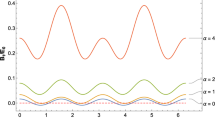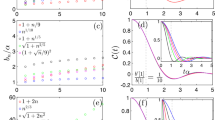Abstract
Wavefunction collapse models modify Schrödinger's equation so that it describes the rapid evolution of a superposition of macroscopically distinguishable states to one of them. This provides a phenomenological basis for a physical resolution to the so-called “measurement problem.” Such models have experimentally testable differences from standard quantum theory. The most well developed such model at present is the Continuous Spontaneous Localization (CSL) model in which a universal fluctuating classical field interacts with particles to cause collapse. One “side effect” of this interaction is that the field imparts energy to the particles: experimental evidence on this has led to restrictions on the parameters of the model, suggesting that the coupling of the classical field to the particles must be mass-proportional. Another “side effect” is that the field imparts momentum to particles, causing a small blob of matter to undergo random walk. Here we explore this in order to supply predictions which could be experimentally tested. We examine the translational diffusion of a sphere and a disc, and the rotational diffusion of a disc, according to CSL. For example, we find that the rms distance an isolated 10−5 cm radius sphere diffuses is ≈(its diameter, 5 cm) in (20 sec, a day), and that a disc of radius 2 ⋅ 10−5 cm and thickness 0.5 ⋅ 10−5 cm diffuses through 2πrad in about 70 sec (this assumes the “standard” CSL parameter values). The comparable rms diffusions of standard quantum theory are smaller than these by a factor 10−3±1. It is shown that the CSL diffusion in air at STP is much reduced and, indeed, is swamped by the ordinary Brownian motion. It is also shown that the sphere's diffusion in a thermal radiation bath at room temperature is comparable to the CSL diffusion, but is utterly negligible at liquid He temperature. Thus, in order to observe CSL diffusion, the pressure and temperature must be low. At the low reported pressure of 5 ⋅ 10−17 Torr, achieved at 4.2°K, the mean time between air molecule collisions with the (sphere, disc) is ≈(80, 45)min. This is ample time for observation of the putative CSL diffusion with the standard parameters and, it is pointed out, with any parameters in the range over which the theory may be considered viable. This encourages consideration of how such an experiment may actually be performed, and the paper closes with some thoughts on this subject.
Similar content being viewed by others
References
E. Schrödinger, Naturwiss. 23, 807(1935).
P. Pearle, Phys. Rev. A 39, 2277(1989).
G. C. Ghirardi, P. Pearle, and A. Rimini, Phys. Rev. A 42, 78(1990).
G. C. Ghirardi, A. Rimini, and T. Weber, Phys. Rev. D 34, 470(1986); G. C. Ghirardi, A. Rimini, and T. Weber, Phys. Rev. D 36, 3287 (1987); G. C. Ghirardi, A. Rimini, and T. Weber Found. Phys. 18, l(1988). F. Benatti, G. C. Ghirardi, A. Rimini, and T. Weber, Nuovo Cimento B 100, 27(1987); F. Benatti, G. C. Ghirardi, A. Rimini, and T. Weber, Nuovo Cimento B 101, 333(1988). J. Bell, in Speakable and Unspeakable in Quantum Mechanics (Cambridge University Press, Cambridge, 1987), p. 201.
P. Pearle, Phys. Rev. D 13, 857(1976); Int. Theor. Phys. 48, 489(1979; Found. Phys. 12, 249(1982); Phys. Rev. D 29, 235(1984); in The Wave-Particle Dualism, S. Diner et al., eds. (Reidel, Dordrecht, 1984); J. Stat. Phys. 41, 719(1985); in Quantum Concepts in Space and Time, R. Penrose and C. J. Isham, eds. (Clarendon, Oxford, 1986); Phys. Rev. D 33, 2240(1986); in New Techniques in Quantum Measurement Theory, D. M. Greenberger, ed. (N.Y. Acad. Sci., New York, 1986), p. 539.
For some other collapse models, see N. Gisin, Helv. Phys. Acta 62, 363(1989). V. P. Belavkin, Phys. Lett. A 140, 355(1989). I. C. Percival, Proc. Roy. Soc. A 451, 503(1995) I. C. Percival and Quantum State Diffusion (Cambridge University Press, Cambridge, 1998). L. P. Hughston, Proc. Roy. Soc. A 452, 953(1995). R. Penrose, Gen. Rel. and Grav. 28, 581(1996). D. Fivel, Phys. Rev. A 56, 146(1997). S. L. Adier and L. P Horwitz, J. Math. Phys. 41, 2485(2000).
For a recent review of CSL, see P. Pearle in Open Systems and Measurement in Relativistic Quantum Theory, H. P. Breuer and F. Petruccione, eds. (Springer, Heidelberg, 1999), p. 195.
G. C. Ghirardi and A. Rimini, in Sixty-Two Years of Uncertainty, A. Miller, ed. (Plenum, New York, 1990), p. 167.
E. J. Squires, Phys. Lett. A 158, 431(1991).
L. E. Ballentine, Phys. Rev. A 43, 9(1991).
P. Pearle and E. Squires, Phys. Rev. Lett. 73, 1(1994).
B. Collett, P. Pearle, F. Avignone, and S. Nussinov, Found. Phys. 25, 1399(1995).
P. Pearle, James Ring, J. I. Collar, and F. T. Avignone, III, Found. Phys. 29, 465(1999).
F. Karolyhazy, Nuovo Cimento A 42, 1506(1966). F. Karolyhazy, A. Frenkel, and B. Lukacs, in Physics as Natural Philosophy, A. Shimony and H. Feshbach, eds. (M.I.T. Press, Cambridge 1982), p. 204; in Quantum Concepts in Space and Time, R. Penrose and C. J. Isham, eds. (Clarendon, Oxford, 1986), p. 109; A. Frenkel, Found. Phys. 20, 159(1990).
F. Benatti, G. C. Ghirardi, and R. Grassi, Found Phys. 35, 5(1995).
A. Bassi and G. C. Ghirardi, Brit. J. Phil. Sci. 50, 719(1999).
L. Diosi, Phys. Lett. A 132, 233(1988).
L. Diosi, Phys. Rev. A 40, 1165(1989).
G. Gabrielse et al., Phys. Rev. Lett. 65, 1317(1990).
For a nice treatment, see R. M. Mazo in Stochastic Processes in Nonequilibrium Systems, Lecture Notes in Physics, Vol. 84, L. Garrido, P. Seglar, and P. J. Shepard, eds. (Springer, Berlin, 1978), p. 53.
R. A. Millikan, Phys. Rev. 32, 349(1911); Phys. Rev. 22, 1 (1923).1
M. D. Allen and O. G. Raabe, Aerosol Sci. and Tech. 4, 269(1985).
E. Cunningham, Proc. Roy. Soc. 83, 357(1910).
P. S. Epstein, Phys. Rev. 23, 710(1924).
A. Einstein and L. Hopf, Ann. Phys. 33, 1105(1910).
A. Einstein, Phys. Z. 10, 185(1909).
A. Einstein, Ann. Phys. 17, 549(1905).
E. N. daC. Andrade and R. C. Parker, Proc. Roy. Soc. 159, 507(1937).
H. Lamb, Hydrodynamics (Dover, New York, 1945), p. 605.
A. Einstein, Ann. Phys. 19, 371(1906).
H. Lamb, op. cit., p. 589.
P. Pearle, Found. Phys. 30, 1145(2000).
We are indebted to Frank Avignone for supplying recent data and to Jim Ring for analyzing it.
Q. Fu, Phys. Rev. A 56, 1806(1997).
G. C. Ghirardi, R. Grassi, and A. Rimini, Phys. Rev. A 42, 1057(1990).
P. Pearle and E. Squires, Found. Phys. 26, 291(1996).
F. Aicardi, A. Borsellino, G. C. Ghirardi, and R. Grassi, Found. Phys. Lett. 4, 109(1991).
B. T. Chen et al., J. Aerosol. Sci. 24, 181(1993).
D. M. Tanenbaum et al., J. Vac. Sci., submitted; Cornell Project 789-99.
W. Paul, Rev. Mod. Phys. 60, 531(1990).
R. F. Wuerker et al., J. Appl. Phys. 30, 342(1958).
S. Arnold, J. H. Li, S. Holler, A. Korn, and A. F. Izmailov, J. Appl. Phys. 78, 3566(1995).
S. Arnold, L. M. Foley, and A. Korn, J. Appl. Phys. 74, 4291(1993).
J. S. Hoye and I. Brevik, Physica A 196, 241(1993). We would like to thank Peter Milonni for calling our attention to this paper.
J. D. Jackson, Classical Electrodynamics (Wiley, New York, 1975), p. 414.
J. D. Jackson, ibid., p. 805.
Author information
Authors and Affiliations
Rights and permissions
About this article
Cite this article
Collett, B., Pearle, P. Wavefunction Collapse and Random Walk. Foundations of Physics 33, 1495–1541 (2003). https://doi.org/10.1023/A:1026048530567
Issue Date:
DOI: https://doi.org/10.1023/A:1026048530567




